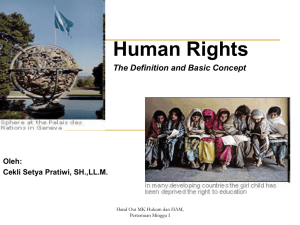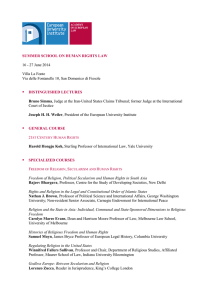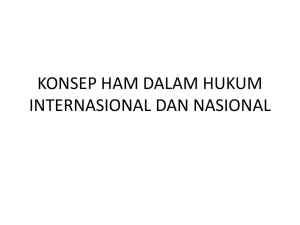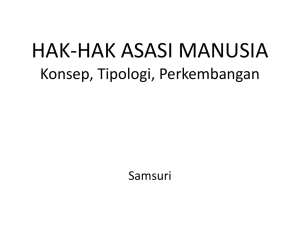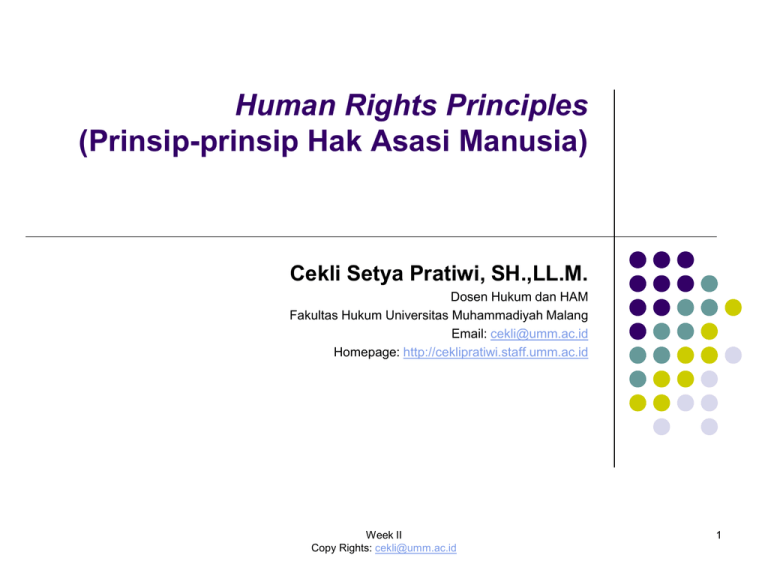
Human Rights Principles
(Prinsip-prinsip Hak Asasi Manusia)
Cekli Setya Pratiwi, SH.,LL.M.
Dosen Hukum dan HAM
Fakultas Hukum Universitas Muhammadiyah Malang
Email: cekli@umm.ac.id
Homepage: http://ceklipratiwi.staff.umm.ac.id
Week II
Copy Rights: cekli@umm.ac.id
1
Universality
Equality/ Non
Discrimination
State Obligation
HAM
Invisibility
Inaliniable
Interelated/
Interdependency
2
1. Prinsip Universalitas
Pada hakekatnya HAM adalah hak yang
melekat pada diri manusia karena kodratnya
dia sebagai manusia
Oleh karenanya hak asasi manusia tidak
memandang perbedaan karena status sosial,
budaya, agama, jenis kelamin, budaya dll
Week II, on March 2010, Faculty of Law, UMMCopy Rights@c.s.pratiwi
3
Prinsip Universalitas dalam
DUHAM
Prinsip universal dimaksudkan bahwa hak asasi ini
adalah milik semua orang karena kodratnya sebagai
manusia
DUHAM Pasal 1: “All human beings are born free
and equal in dignity and rights”. Penggunaan istilah
“all human beings” berarti bahwa “everyone (setiap
orang)” memiliki hak yang sama atau dengan kata
lain “ no one (tidak seorangpun)” boleh diabaikan
hak-haknya atau diperlakukan secara berbeda
berdasarkan misalnya perbedaan ras, warna kulit,
jenis kelamin, bahasa, agama, politik yang dianut,
kebangsaan, atau asal usul, tingkat kekayaan,
kelahiran, atau status yang lainnya.
Week II, on March 2010, Faculty of Law, UMMCopy Rights@c.s.pratiwi
4
Prinsip Universalitas dalam
CCPR 1966
Istilah yang menunjukkan prinsip
universalitas ini juga ditemui di beberapa
Konvensi HAM lainnya seperti CCPR
memakai kata “every human beings” di
Pasal 6, kata “every on” di Pasal 9 ayat (1),
12 (1), (2), Pasal 14 (2), (3) dan (5), Pasal
16, Pasal 17 (2), PAsal 18 (1), Pasal 19,
dan PAsal 22.
Week II, on March 2010, Faculty of Law, UMMCopy Rights@c.s.pratiwi
5
Prinsip Universalitas dalam
American Convention
Sedangkan istilah “all person” dipakai di Pasal 10 (1), 14 (1), 26,
“anyone” di Pasal 6 (4), Pasal 9 (2-5) serta kata “no one” di
Pasal 6,7,11,15, dan 17 (1). Di Konvensi HAM Amerika
(American Convention on Human Rights 1969) juga dijumpai di
hamper setiap pasal yang secara keseluruhan berjumlah 43
pasal penggunaan istilah ”every person”, ”no one”, ”every one”,
“any one” secara bergantian. Lebih menarik dalam salah satu
ketentuan yaitu Pasal 19 secara khusus disebut istilah “every
minor child”[1] yang menunjukkan bahwa secara eksplisit dan
tegas hak anak kecil diperhatikan sebagai bagian dari keluarga,
masyarakat dan Negara Amerika Serikat dalam Konvensi HAM
Amerika ini.
-----------------------[1] Article 19: “every nimor child has the right to the measures of
protection requaried by his condition as a minor, on the part of
his family, society and the State.”
Week II, on March 2010, Faculty of Law, UMMCopy Rights@c.s.pratiwi
6
Sedangkan dalam African Charter on Human
Rights and People’s Rights di beberapa
Pasal yang berjumlah 51 pasal
menggunakan istilah yang sedikit berbeda
yaitu “every individual” dan “all peoples”.
Week II, on March 2010, Faculty of Law, UMMCopy Rights@c.s.pratiwi
7
Topic Discussion
Bagaimana prinsip2 HAM tersebut diakui
dan dijamin dalam berbagai peraturan
perUUan HAM di Indonesia?
Week II, on March 2010, Faculty of Law, UMMCopy Rights@c.s.pratiwi
8
2. Equality and non discrimnitaion
DUHAM Pasal 1 : “All human beings are born free
and equal in dignity and rights…..”.
CESCR Pasal 2 : “…..Everyone is entitled to al
rights and freedoms set forth in this declaration,
without distinction of any kind, such as race,
colour, sex, language, religion, political, or other
opinion, national, or social origion, property, birth or
other status”. Perlindungan HAM di tingkat regional
seperti benua Eropa, Amerika dan Afrika, prinsip
equality ini juga diadobsi secara jelas.
Week II, on March 2010, Faculty of Law, UMMCopy Rights@c.s.pratiwi
9
in USA
USA: Konvensi HAM Amerika (American Convention on Human
Rights 1969) yang ditandatangai di San Jose pada 22 November
1969 dan berlaku efektif sejak 18 Juli 1978 misalnya pada
bagian Pembukaan disebutkan bahwa:[1]
”The American States signatory to the present
Convention,.....Recognizing that the essential rights of man are not
derived from one’s being a national of a certain state but are based
upon attributes of the human personality, and that they therefore
justify international protection in the form of a Convention reinforcing
or complementing the protection provided by the domestic law of
American States.”
---------------------------------------------[1] Lihat American Convention on Human Rights di International
Law, Human Rights, Mr. P. van Dijk (et.all), (eds)., Fourth
Revised edition, Koninklijke vermande, page. 277.
Week II, on March 2010, Faculty of Law, UMMCopy Rights@c.s.pratiwi
10
in Europe
Begitu pula di region Eropa melalui European Social Charter
(Undang-Undang Sosial Eropa) yang disahkan di Turin pada 18
Oktober 1961 dan berlaku efektif sejak 26 Februari 1965 pada
Alenia III dinyatakan bahwa :[1]
“The Governments signatory hereto, being Members of the Council of
Europe,…..Considering that the enjoyment of social rights should be
secured withouth discrimination on the grounds of race, colour, sex,
religion, political opinion, national extraction or social origion.
----------------------------------[1] Lihat American Convention on Human Rights di International
Law, Human Rights, Mr. P. van Dijk (et.all), (eds)., Fourth
Revised edition, Koninklijke vermande, page. 277.
Week II, on March 2010, Faculty of Law, UMMCopy Rights@c.s.pratiwi
11
in Saudi Arabia
Menurut The Arab Charter of Human Rights
yang disahkan pada tanggal 15 September
1994, pada Pembukaan Alenia II dinyatakan
bahwa:
“Having achievement the everlasting principles
established by the Islamic Shari’a and the other
divine religions enshrined in brotherhood and
equality v amongst human beings”.
Week II, on March 2010, Faculty of Law, UMMCopy Rights@c.s.pratiwi
12
Diskusi:
Bagaimana pengakuan prinsip “equality” dan
“non diskriminasi” di Indonesia?
Week II, on March 2010, Faculty of Law, UMMCopy Rights@c.s.pratiwi
13
3. Prinsip Indivisible and
interdependent
Resolusi Majelis Umum PBB Nomor 32/130 pada Desember
1977 menyatakan bahwa:
“(a) All human rights and fundamental freedoms are indivisible
and interdependent; equal attention and urgent consideration
should be given to the implementation, promotion, and protection
of both civil and political, and economical, social and cultural
rights; (b) The full realization of civil and political rights
without the enjoyment of economic, social and cultural
rights is impossible; the achievement of lasting progress in the
implementation of human rights is dependent upon sound and
effective national and international policies of economical and
social development, as recognized by the Proclamation of
Teheran of 1968”.[1]
---------------------------[1] United Nations. 2001. Fact Sheet No. 16 (Rev.1). ibid. hal.5.
Week II, on March 2010, Faculty of Law, UMMCopy Rights@c.s.pratiwi
14
4. Prinsip Inalienability
Hak asasi setiap manusia tidak dapat
digantikan atau diwakilkan kepada manusia
lainnya
HAM tidak dapat dicabut sewenang-wenang
oleh negara
Week II, on March 2010, Faculty of Law, UMMCopy Rights@c.s.pratiwi
15
5. State Obligation
Pemenuhan HAM adalah kewajiban negara
Kewajiban negara meliputi:
1. obligation to protect
2. obligation to respect
3. obilagtion to ensure/ guarentee
4. obligation to take step
5. obligation to fulfill
Week II, on March 2010, Faculty of Law, UMMCopy Rights@c.s.pratiwi
16

